

December 2011

| Quick Links | |
| Aquatic: | Stream, Pond, Vernal Pool |
| Wetlands: | Low Wetland, Upland Seep |
| Woodlands: | Dry Upland Woods, Moist Upland Woods, Floodplain Woods |
| Open Lands: | Grassland, Edge |
Introduction
Despite its narrow confines and modest length, Sligo Creek Park is home to a wide variety of habitats, each with its own qualities based on soil, sunlight, slope, aspect (facing which direction), and water. Different combinations of these qualities support different sets of plants and animals that are adapted to them.
|


|
PHOTOS: All photos by Michael Wilpers, except vernal pool, by Ed Murtagh
| Habitat Name | What It Looks Like | What's There | Where To Find It |
|---|---|---|---|
| AQUATIC | |||
| Stream |  |
Sligo Creek's waters move through deep, quiet sections (called pools) and shallow, fast-moving sections (called riffles). In pools, about a dozen species of small fish congregate below the surface, while mallards, wood ducks, and water striders occupy the surface. The riffles are where insect larvae, aquatic worms, and fresh-water snails affix themselves to rocks and feed on passing food, especially bits of decaying leaves that fall in great quantities from above.
Throughout the streams, yellow-crowned night-herons hunt for abundant crayfish (their specialty), while green herons, great blue herons, and black-crowned night-herons catch a variety of stream critters, including salamanders. Raccoons do the same under cover of night, leaving many tracks at the water's edge that can be seen in daytime. Water snakes often swim by or bask on rocks and fallen logs, as do snapping turtles. On summer evenings, bats cruise above the creek, catching insects as they hatch into their adult forms and emerge from the water. More often than one might expect, muskrat and beaver take up residence, with the beaver leaving many smalll tree stumps behind. Left: Sligo Creek main stem, with a deep, quiet pool flowing into a shallow, fast-moving riffle, between New Hampshire Avenue and the Pepco powerline corridor. |
Sligo Creek Wheaton Branch Long Branch Smaller tributaries |
| Pond |  |
Sligo's artificial ponds, built for stormwater control, support freshwater snails, small fish, six species of frogs (during breeding season), and a variety of dragonflies and damselflies, among other animals. Feeding on all this life are belted kingfishers, eastern kingbirds, green herons, great blue herons, and black-crowned and yellow-crowned night-herons. Mallards and wood ducks feed on submerged vegetation, sharing the water with Canada geese. Painted turtles and red-eared sliders often bask along the banks or on logs in the summer and spend the winter months buried in the mud at the bottom of the ponds. Occasionally, a beaver will establish a den along the bank, taking down a number of trees in the process and sometimes blocking the pond's exit pipe, causing the pond to flood.
Left: One of the Wheaton Branch stormwater ponds, with geese and goslings afloat. |
Kemp Mill stormwater ponds, just north of Univ. Blvd, near the Kemp Mill shopping center
Wheaton Branch stormwater ponds, just south of Dennis Avenue and west of Inwood. Small ponds just south of the Beltway, between the parkway and the creek Stormwater ponds just north of Forest Glen Road, between the parkway and the creek |
| Vernal Pool | 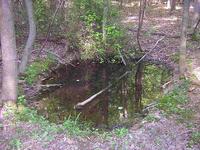 |
Wet only during spring and early summer when they accumulate rain water, vernal pools provide important habitats because they contain no fish. With these predators absent, wood frogs and spotted salamanders can breed here in very early spring after arriving from their upland feeding areas, where they spend most of the year. These ephemeral ponds support an array of tiny creatures that provide food for growing tadpoles, including daphnia, seed shrimp, leeches, and isopods.
That's Not a Puddle, It's a Vernal Pool Vernal Pool Walk - March 4, 2006 Left: Vernal pool in Kemp Mill woodland |
Kemp Mill, between hiker-biker trail and the creek, north of the split in the trail
Wheaton Branch, along the foot path south of Woodman Ave. (Breeding frogs & salamanders were last reported here in the 1990s.) |
| WETLANDS | |||
| Low Wetland | 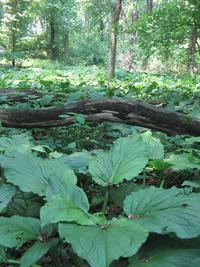 |
In these low-lying areas, the soil is wet most of the year. Skunk cabbage grows in profusion here and is considered an indicator of valuable wetland habitat. Overhead are water-tolerant trees such as red maple, sycamore, green ash, tulip tree, and pin oak, with abundant spicebush underneath. The wet conditions limit the variety of herbaceous plants, but one can typically find lady fern, New York fern, sensitive fern, Jack-in-the-Pulpit, and bog hemp (false nettle).
Left: Skunk cabbage dominates the herbaceous layer in the wetland across the creek, and a bit upstream, from the Dennis Avenue Recreation Center. |
Just north of Dennis Avenue, between the Dennis Ave. Recreation Center and the hiker-biker trail
Kemp Mill, just upstream from the split in the hiker-biker trail, on either side of the trail (this may be a Seep, see below) Smaller wetlands with Skunk Cabbage located elsewhere in the Park. |
| Upland Seep | 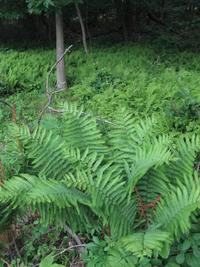 |
When the underground water table encounters the surface along a slope, water emerges to create an upland seep or swamp. Skunk cabbage is abundant, identifying it as a true wetland. Also found there are abundant New York fern, sensitive fern, and Jack-in-the-Pulpit, along with royal fern, cinnamon fern, lady fern, and several sedges.
Left: Cinnamon fern (foreground) and New York fern in the upland seepage area above the west bank of the Kemp Mill stormwater ponds. This is the only location where cinnamon fern grows in Sligo. See a album of plant photos in an upland seepage swamp in Kemp Mill. |
In Kemp Mill, just west of the stormwater ponds
Kemp Mill, just upstream from the split in the hiker-biker trail, on either side of the trail (tentatively identified as a Seep) |
| WOODLANDS | |||
| Dry Upland Woods | 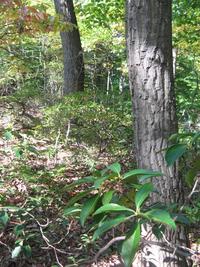 |
Dry woods have steep, rocky slopes and thin soil that cause rain water to run off more than soak in. Chestnut oak is an indicator species for these dry conditions and is abundant between New Hampshire Avenue and the Pepco corridor. It appears with above a shrub layer with mountain laurel and maple-leaved viburnum, and alongside several other oaks, pignut hickory, American beech, red maple, and tulip tree.
Abundant leaf-eating caterpillars in the trees provide food for many birds, while the bountiful acorns are eaten by deer, raccoons, squirrels, chipmunks, mice, woodpeckers, titmice, nuthatches, grackles, and blue jays. Left: Chestnut oaks and mountain laurel in the dry woods on the north-facing slope between New Hampshire Avenue and the Pepco corridor |
Between Piney Branch Road and the Pepco corridor, especially the north-facing slope below New Hampshire Ave. |
| Moist Upland Woods | 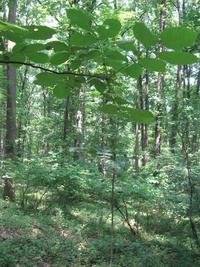 |
In moist, upland woods, gentle slopes and deep, rich soil allow rainwater to soak into the ground, providing plenty of moisture for luxuriant plant growth. Most distinctive of this habitat are the briefly flowering "spring ephemerals" such as the widespread mayapple, trout lily, Solomon's plume (false Solomon's seal), and spring beauty, as well as more localized Dutchman's breeches, pink lady's slipper, ramp, star chickweed, and cut-leaved toothwort, all pollinated by native solitary bees. Rich soils in these woods support Christmas and rattlesnake fern, Indian, pipe, and a number of rare spring flowers.
In the canopy are abundant tulip trees, several oaks, mockernut hickory, American beech, black gum, sassafras, dogwood, and ironwood (Carpinus), with a shrub layer of spicebush (especially on lower slopes) and maple-leaved viburnum, with occasional strawberry bush and pinxster azalea. The deep, moist leaf-litter is home to most of Sligo's box turtles. As in dry woods, the abundant leaf-eating caterpillars provide food for many birds, while a reliably vast crop of acorns are eaten by deer, raccoon, squirrels, chipmunks, mice, woodpeckers, titmice, nuthatches, grackles, wood ducks, and blue jays. Red-tailed hawks prefer these woods for their nesting sites. Left: Mockernut hickory sapling (above) and spicebush (below) in the moist upland woods between the hiker-biker trail and Sligo Middle School |
The largest tracts of this habitat are:
Above University Blvd., west/southwest of the stormwater ponds; behind Magruder's grocery story; and north of the hiker-biker trail after the trail splits Just north of Dennis Ave., between Sligo Middle School and the creek From the confluence of Sligo Creek and Wheaton Branch northwest to Woodman Long Branch, between Carroll Ave. and the confluence with Sligo; between the Long Branch Community Center and Melbourne |
| Floodplain Woods | 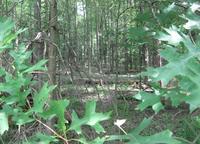 |
Floodplain woods occur in flat, low-lying areas on either side of the creek and its tributaries. The trees here are species that can tolerate occasional flooding. Specializing on the stream and pond banks are box elder, river birch, the uncommon black willow, and the non-native white mulberry. Here and away from the streams are ironwood (Carpinus), red and silver maple, sycamore, American elm, pin oak, green ash and a few stands of paw-paw, many of which are subject to beaver damage. Spicebush is often plentiful, while silky dogwood is uncommon. As in Sligo's wetlands, the herbaceous layer here is less varied than in other woods, but one can find abundant Jack-in-the-Pulpit, lady fern, New York fern, sensitive fern, false nettle (bog hemp), jewelweed (touch-me-not), sedges, and one tiny colony of turtle-head.
Some of our largest birds nest in floodplain woods, including the often-heard barred owl as well as red-shouldered hawks, wood ducks, and (in trees directly over the creek) black-crowned and yellow-crowned night-herons that migrate to Sligo from as far away as the Caribbean in order to breed here each spring. Left: Pin oak, with its downward swooping branches, in the floodplain woods downstream from the Kemp Mill stormwater ponds |
Kemp Mill, between the stormwater ponds and University Blvd.
Kemp Mill, south of the right-hand fork of the hiker-biker trail Wheaton Branch, above the confluence with Sligo Creek, up to where it begins to parallel Woodman Avenue Between the Pepco corridor and East-West Hwy Stream bank trees, shrubs, and herbaceous plants can be found along the entire length of Sligo and its tributaries |
| OPEN LANDS | |||
| Grassland | 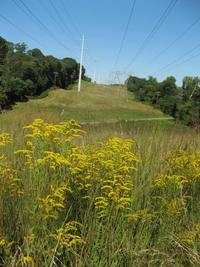 |
Grasslands in the Eastern United States were once created and maintained by fire, but today they are provided by annual mowing. Like fire, mowing prevents shrubs and trees from establishing themselves, leaving the field open to grasses and wildflowers. The mowing also helps keep invasive vines and shrubs under control.
The flowers include butterfly weed, common milkweed, boneset, Joe-Pye weed, goldenrods, dogbane, and yarrow, all of which provide nectar and pollen for a variety of butterflies, bees, wasps, and other pollinators who in turn fertilize the flowers. Meadow voles make their passageways in the dense undergrowth, while red-tailed hawks and red fox search them out for food. . Left: Goldenrod in the grassland along the Pepco powerline corridor |
In the Pepco powerline corridor between New Hampshire Ave. and East-West Highway
Across from Sligo Golf Course, between the Beltway & the soccer fields Just north of the Beltway on the east side of the hiker-biker trail The hillsides surrounding the Wheaton Branch stormwater ponds (although these are mowed twice a year so that safety inspectors can look for faults that might endanger downstream homes) |
| Edge |  |
Where woodland meets open space, one finds a narrow transition zone called an "edge," which has its own habitat qualities. Sun-loving shrubs are abundant here, providing fruits of great value to wildlife, such as tall blackberry and common and glaucous greenbriers. Also here are plants rarely seen in other Sligo habitats, including winged sumac, trumpet vine, and Hercules' club.
Abundant dogbane and goldenrods provide nectar and pollen for insects. Eastern towhees sing in the trees high above their well-hidden nesting sites, chipmunks dig their burrows underground, and cottontail rabbits escape to the dense thorny cover for protection from foxes. Also flourishing along these edges are some of our most widespread and aggressive non-native invasives, especially such vines and shrubs as mile-a-minute, porcelainberry, Japanese honeysuckle, multiflora rose, bush honeysuckle, and wineberry. Left: Plentiful fruits of tall blackberry in edge habitat along the Pepco powerline corridor |
Many areas throughout the Park, especially around ball fields, when they aren't covered in exotic invasives such as porcelainberry, multiflora rose, and wineberry
The Pepco powerline corridor, between New Hampshire Ave. and East-West Highway Wheaton Branch stormwater ponds, along the eastern and southwestern edges of the property Kemp Mill, the north side of the right branch of the hiker-biker trail |